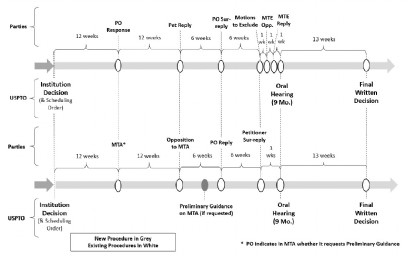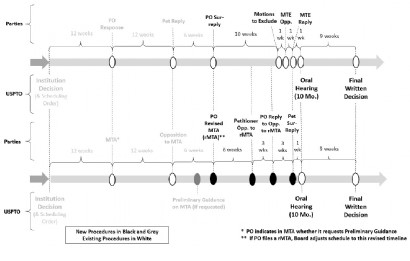USPTO Begins Pilot Program for Motions to Amend in Post-Grant Patent Trial Proceedings
The U.S. Patent and Trademark Office (USPTO) has published a notice announcing a pilot program for motions to amend (MTAs) in post-grant trial proceedings before the Patent Trial and Appeal Board (PTAB). MTAs allow patent owners an opportunity to amend patent claims challenged by a petitioner in a PTAB trial proceeding. The pilot program “provides patent owners with two options not previously available.” First, a patent owner may request “preliminary guidance” from the PTAB on an MTA. Second, a patent owner may file a revised MTA in response to a petitioner’s opposition and/or the PTAB’s preliminary guidance (if requested). This pilot is effective for all proceedings instituted on or after March 15, 2019. Pre-pilot MTA practice remains unchanged except the timing of due dates later in the process will be modified slightly.
Preliminary Guidance
If a patent owner wants to seek preliminary guidance under the pilot, it should make a request in its MTA. The petitioner may file an opposition and supporting evidence in response to the MTA, the same as in pre-pilot practice. As explained in the notice, the preliminary guidance will generally consist of a short paper addressing whether (a) there is a “reasonable likelihood” that the MTA meets statutory and regulatory requirements (e.g., no broadening amendments) and (b) the petitioner establishes a “reasonable likelihood” that the proposed amended claims are unpatentable. The preliminary guidance may be provided orally, at the PTAB’s discretion. The guidance will be non-final and not subject to requests for reconsideration. The patent owner may file a reply in response to the preliminary guidance and the petitioner’s opposition, along with supporting evidence, and the petitioner may file a sur-reply in response.Revised MTA
Under the pilot, the patent owner has the option to file a revised MTA instead of a reply supporting the initial MTA. A revised MTA may present different proposed claims and additional arguments in support of the proposed amendments, but these must respond to the opposition or preliminary guidance (if any). If a patent owner files a revised MTA, the petitioner may file an opposition and supporting evidence. The patent owner will be able to file a reply thereto, and the petitioner may file a sur-reply. All of these papers can include new evidence, except that sur-replies may only include cross-examination testimony.Timing
The PTAB will provide preliminary guidance, if requested, about four weeks after the due date for the petitioner’s opposition to an MTA. If the patent owner files a reply, the schedule will generally proceed as it would without the pilot program. This is shown below by the timeline from Appendix 1A of the notice. The petition schedule is shown on the top, and the MTA schedule is shown on the bottom.Click to enlarge
If the patent owner files a revised MTA, the timeline below (from Appendix 1B of the notice) applies. When a patent owner files a revised MTA, the PTAB expects to move the date of the oral hearing four weeks closer to the statutory deadline for reaching a final written decision.
Click to enlarge
Additional Details and Future Notices
The notice also addresses other scenarios, such as a patent owner opting not to file either a reply or a revised MTA, a petitioner ceasing to participate (the PTAB may opt to seek Examiner assistance), and a patent owner choosing to withdraw its MTA. In addition, the notice specifies that patent owners may continue to move to amend on a contingent basis, i.e., in the event that the original claims are found unpatentable in a final written decision. As explained in the USPTO’s notice, the changes to the MTA procedures are the result of a years-long effort including a request for comment from the USPTO late last year, which sought feedback on a preliminary version of a pilot program. The USPTO will reassess the pilot program after about a year and may terminate or continue the program at any time.
In addition, the notice indicates that the USPTO plans to separately address whether it should engage in potential rulemaking on allocating the burden of persuasion to the petitioner. Earlier in the week, the PTAB designated Paper 15 in Lectrosonics, Inc. v. Zaxcom, Inc., Case IPR2018-01129 (PTAB Feb. 25, 2019) as precedential, which continues to place the burden of persuasion on petitioners to establish amended claims unpatentable. The notice also states that the USPTO plans to issue a future notice on options for patent owners using reissue and reexamination proceedings, “including procedures for options after a petitioner files an AIA petition challenging claims of the same patent, after the Board institutes a trial, and after the Board issues a final written decision.”
Conclusion
The pilot program adds more flexibility for patent owners wanting the ability to amend claims as part of an AIA trial proceeding. Previously, motions to amend have been filed infrequently and without much success. This pilot could have a significant impact on PTAB trials, but patent owners will need to carefully weigh the new options available to them, and consider issues such as cost of proceedings and the impact of any intervening rights for amended claims. Petitioners also should plan for the possibility of motions to amend when deciding to file petitions. All parties involved should be conscious how these changes could impact their cases.


